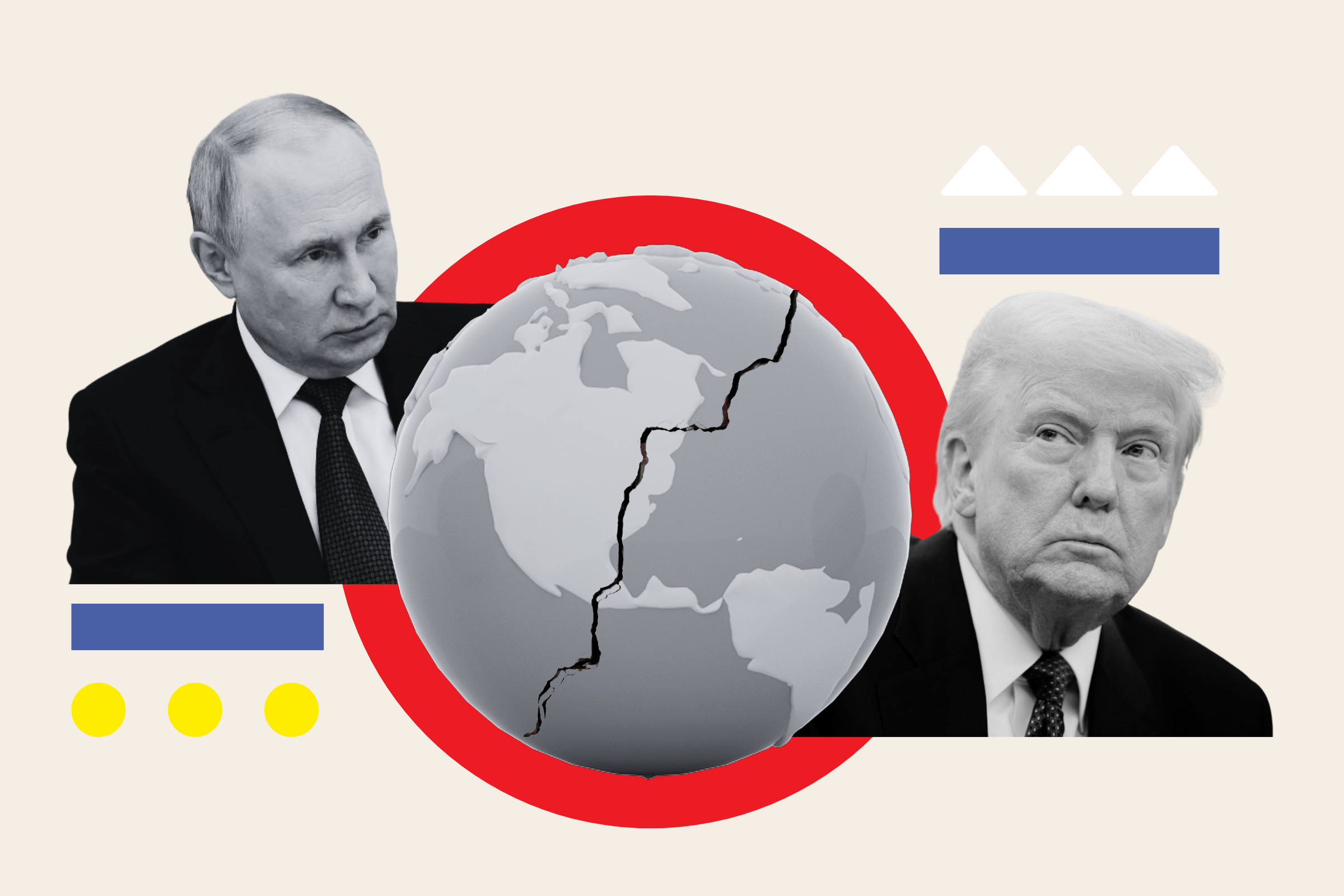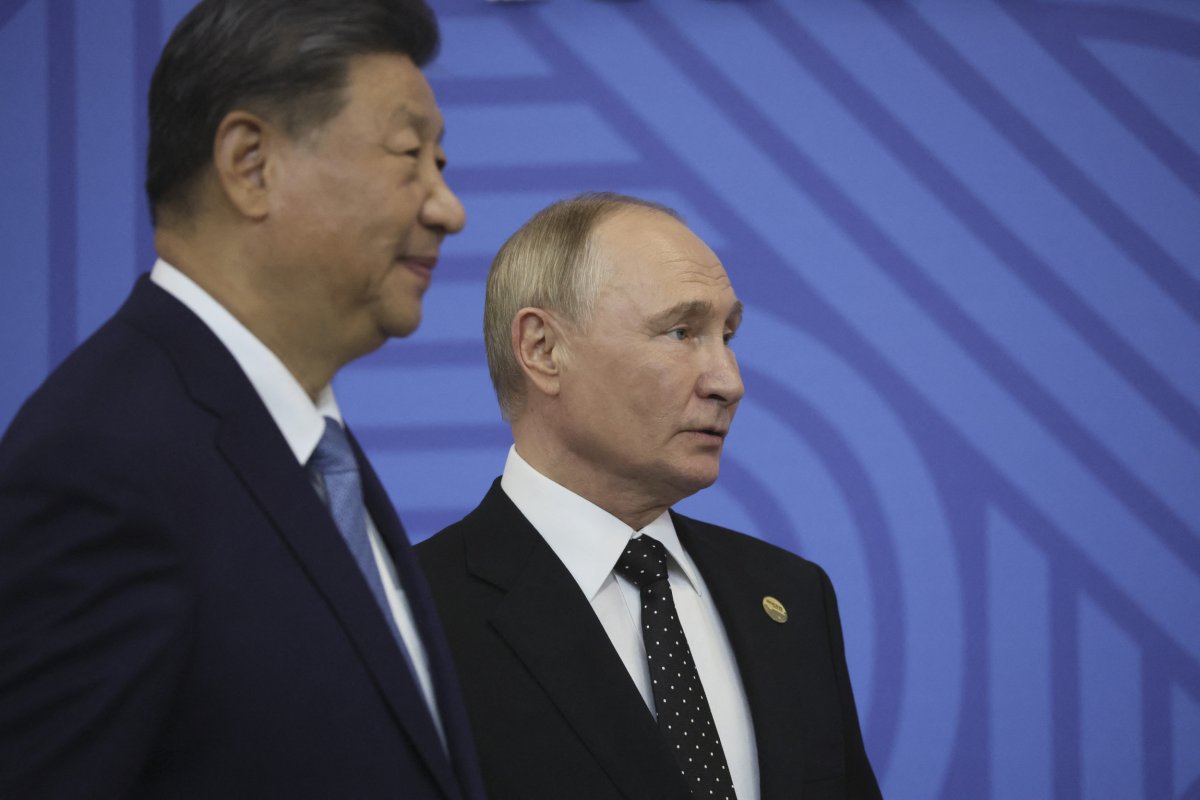
U.S. President Donald Trump‘s outreach to Russian President Vladimir Putin to try to end the war with Ukraine comes amid jockeying among leaders for spheres of influence while China seeks to exert its clout. A map by Newsweek outlines how this global chess game might play out.
A Trump call with Putin in March and American-led shuttle diplomacy in Saudi Arabia showed the resolve of the U.S. president, even as the war rages on despite talks yielding a 30-day ceasefire proposal and a deal to stop Black Sea strikes.
But the process to end the war has echoes of the Yalta conference in 1945 between U.S., U.K. and Soviet leaders that preceded the Cold War division of Europe, according to Vessela Tcherneva, deputy director the European Council on Foreign Relations (ECFR).
Photo Illustration by Newsweek/Getty Images
“Yalta was about great powers deciding about the future of Eastern Europe,” she told Newsweek. “This is what it looks like regarding Ukraine now.”
“Deciding Ukraine’s future without Ukraine is also deciding about Europe’s future without Europe,” she added.
The discussion of Ukraine’s future sparked comparisons of another World War II meeting, according to Stefan Wolff, professor of international security at the University of Birmingham in England.
He said Trump’s refusal to give Ukraine security guarantees was akin to the appeasement of Nazi leader Adolf Hitler at the Munich Conference in 1938. Wolff believes the current U.S. president sees the world as one in which great powers carve out spheres of influence which they don’t interfere in.
“We are probably going to see superpowers divvying up the globe between them—China and the U.S.—and it’s still a bit unclear what will happen with Russia, whether it will be a player in its own right or even more dependent on China.”
Russia’s Sway In Eastern Europe
Munich was also the scene of U.S. Vice President JD Vance’s excoriation of the EU’s democracies over accusations of silencing free speech and failing to stop mass migration as well as his demands for more openness to right-wing populists that was praised by Putin’s ally, former Russian President Dmitry Medvedev.
The speech followed U.S. Defense Secretary Pete Hegseth saying restoring Ukraine’s territory to pre-2014 borders was unrealistic and that European countries needed to do more for their own defense as the United States needed to counter China in the Pacific.
Tcherneva said the Trump administration’s stance suggests Eastern Europe may be cast adrift, which is concerning given Russia’s sway in the domestic politics of countries like the Czech Republic, Slovakia, Bulgaria, Romania and Poland.
She said Russia is trying to undermine democracies in Eastern Europe and is “working on moving societies to a different to a new consensus, which now seems to be very comfortable in the Trump era.”
The specter of Putin has hung over protests and elections in several countries in Eastern Europe in recent months.
Moscow is accused by pro-Western politicians of interfering in an EU referendum and presidential ballot in Moldova, while in neighboring Romania, elections were canceled by pro-EU leaders after far-right front-runner Calin Georgescu led the first round amid claims of Russian meddling.
In several European countries, protests have been taking place against governments that are seen as taking a more pro-Kremlin line.
Protesters in Slovakia took to the streets of Bratislava to protest an amendment to a bill restricting NGOs likened to Russia’s foreign agent law in the country whose leader, Robert Fico, has been criticized by opponents for his links to Moscow.
March saw protests in Serbia, where President Aleksandar Vučić has close ties with Moscow, while Kremlin’s perceived hand in Hungarian politics has drawn backlash against Prime Minister Viktor Orban, one of Putin’s closest EU allies.
Further south, agitation in Georgia has seen protests against the ruling Georgian Dream group, whose critics accuse it of links to Moscow and which is consolidating its grip on the South Caucasus country with strategically important Black Sea access.

MAXIM SHIPENKOV/Getty Images
China And Central Asia
Central Asia could be an areas of contest between Russia and China.
As a sign of diplomatic intent, Putin received a warm welcome in Mongolia last September in his first visit to a member of the International Criminal Court (ICC) since it issued an arrest warrant for alleged war crimes. Mongolia relies on Russia for fuel and electricity and China for investment in its mining industry.
Wolff said it was significant that the first overseas trip Chinese leader Xi Jinping made following the COVID pandemic was to the former Soviet republic of Kazakhstan, whose leader, Kassym-Jomart Tokayev, has spoken out against Putin’s invasion of Ukraine
“There has always been a worry in Astana that [it] might be Russia’s next expansion target,” Wolff said, with the country holding a significant Russian population.
“The Kazakhs can be a little bit more skeptical about Russia and Ukraine, because they know the Chinese have been clear that they will not let Russia mess with northern Kazakhstan where there is a significant Russian population.”
China, Trump And The Western Hemisphere
Trump has repeatedly said he wants to acquire Greenland and take control of the Panama Canal, angered Canada by describing it as a potential 51st state and renamed the Gulf of Mexico to reflect his American-first philosophy.
Wolff said Trump is retrenching to the Western Hemisphere but may face push-back from China, particularly in Latin America.
“That’s going to probably encourage Trump to focus even more on the Western Hemisphere and ditch whatever he thinks are pointless liabilities that he has elsewhere,” he said.
But Trump hasn’t gained what he wanted from Putin regarding a deal over Ukraine yet and if Moscow cannot strike a deal with the U.S., its dependence on China will grow.
However, headlines about Ukraine have been superseded by Trump’s ramping up his trade war with China, which now faces 145 percent tariffs. This could potentially weaken Putin as Xi may align its economic interests more with Europe.
“China will then have to weigh its relationship with Russia versus its relationship with the European Union,” Wolff said.
There is the also question of whether there will be an arrangement between the U.S. and China over Taiwan, the autonomous island that Beijing considers to be a rebel region that must be reunited with the mainland, by force if necessary.
The Chinese military’s Eastern Theater Command’s latest military drills around Taiwan this week amplified the question of what Trump would do if Beijing invades.
Wolff said Xi may not be ready to take Taiwan by force yet as there are other hotspots in the South China Sea where the U.S. potentially would be obliged to intervene against Chinese belligerence, such as the Philippines.
“You could have those tacit arrangements where the Chinese push and the U.S. doesn’t push back,” Wolff said. “Then it becomes clear that there is an implicit recognition that really the South China Sea is China’s to play with.”
